
| INTRO | PARTS |
SETS Moubal Jumbo |
MANUALS Moubal Jumbo |
MARKETING | PRICE LISTS |
BUILDING |
MOUBAL RELATED |
 |
||||||||
|
MARKETING - INDEX
MOUBAL PERIOD (1924 - 1951): 1924 Mobaco display card 1925 Mobaco art deco poster 1925-03-11 Utrechts Nieuwsblad article - Mobaco at the 1925 Jaarbeurs Trade Fair 1927-09-09 Utrechts Nieuwsblad article - Mobaco at the 1927 Jaarbeurs Trade Fair 1931-09-12 Zeister Courant article - Mobaco and other Moubal products at the 1931 Jaarbeurs Fall Fair 1931-09-17 Utrechts Nieuwsblad article - Mobaco at the 1931 Jaarbeurs Fall Fair The gnomes sales brochure (Het Kabouterboekje) - Version 1, with Set Z (probably 1931) English version German version Spanish version - Version 2, with Set 000 (probably 1932) - Version 3, with square windows and Art Deco doors (probably 1933) Ads for Mobaco demonstrations Unpriced ads - Moubal period (1924 - 1951) Van den Bosch, Zeist Bosch-Honig, Utrecht JUMBO PERIOD (1949 - 1961) Jumbo display poster 1955 Hausemann & Hötte display at the Jaarbeurs Trade Fair Unpriced ads - Jumbo period (1949-1961) It appears that marketing of Mobaco was primarily through retail stores. They handed out colorful price lists to prospective customers, organized "demonstrations", and placed ads in local newspapers. In addition, Mobaco was on display at some of the Jaarbeurs trade fairs in Utrecht, which were attended by many people. Newspaper accounts indicate there were Mobaco displays at the fair in 1925, 1927 and 1931. The first real brochure was a colorful 12-page booklet, commonly referred to as the Gnomes Book, from 1931. More about that below Here all marketing material that has been found so far. For the Price lists and other marketing materials that mention prices, see the Price Lists page. THE 1930-1931 REFRESH 1930 and/or 1931 seems to have been a special year, in which a number of changes were made, essentially re-branding Mobaco from an instructive architectural construction system to a fun toy. The refresh affected all aspects of Mobaco, specifically:
 The article in Natuur en Techniek from 1931 may also have been part of this new push. And in the next year, Moubal brought out Set 000 in a totally different type of box, with a much simpler and cheaper construction. |
|||||||||||||||||||||||||||||||||||||||||||||||||||||||||||
1924 - MOBACO DISPLAY CARD This display card is identical to the Set 1 manual cover, overprinted with BOUWDOOZEN (construction sets), NEDERLANDSCH FABRIKAAT (made in the Netherlands), and the prices of Sets 1 and 2. The size is 302 x 230 mm. It is printed with spot colors black, gray, red, green and light blue. DOWNLOAD 150 dpi PDF 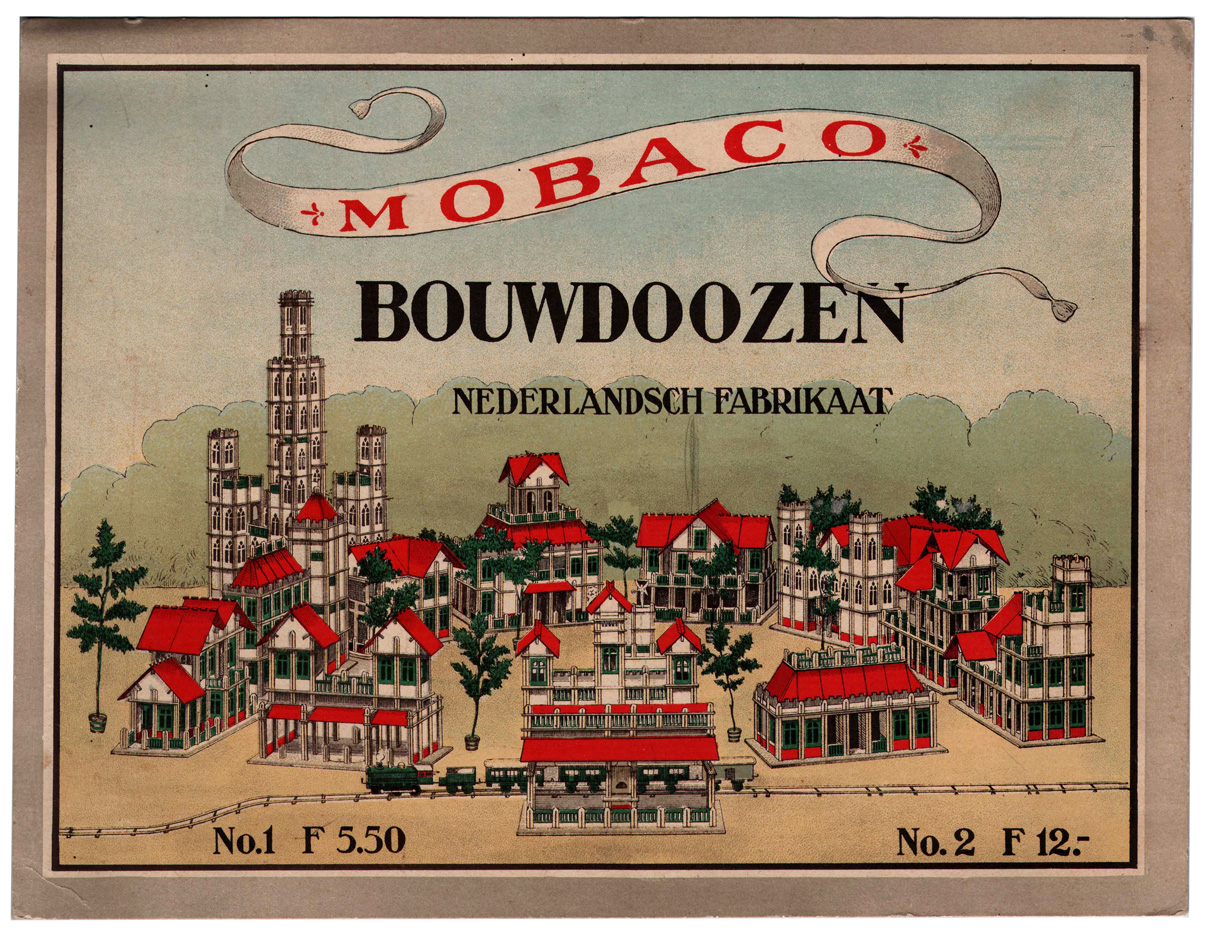 Scan courtesy of Leen Kalden |
|||||||||||||||||||||||||||||||||||||||||||||||||||||||||||
1925 - MOBACO POSTER This colorful poster is 465 x 633 mm (larger than A2). It mentions the 4 sets available in 1925, which helps to date it. This poster shows that Mobaco was originally marketed as an architectural toy, similar to Meccano being advertised as a mechanical toy. It is printed with spot colors: black, gray, red, yellow, green, light blue DOWNLOAD 150 dpi PDF  Original courtesy of Leen Kalden |
|||||||||||||||||||||||||||||||||||||||||||||||||||||||||||
11 MARCH 1925 - MOBACO AT THE JAARBEURS TRADE FAIR ARTICLE IN UTRECHTS NIEUWSBLAD A "report" about the second day of the 1925 Spring Fair in the Jaarbeurs in Utrecht mentions Mobaco, available at the Bosch Honig stand. Bosch Honig was a toy store in Utrecht. Click here for the entire Jaarbeurs article. |
|||||||||||||||||||||||||||||||||||||||||||||||||||||||||||
|
|||||||||||||||||||||||||||||||||||||||||||||||||||||||||||
|
9 SEPTEMBER 1927 - MOBACO AT THE JAARBEURS TRADE FAIR This article in Utrechts Nieuwsblad about the 1927 Fall Fair in the Jaarbeurs in Utrecht mentions Mobaco. The article references Set 4, noting that it has 1135 parts, and states that Bosch Honig have the sole distribution rights. Click here for the entire Jaarbeurs article. |
|||||||||||||||||||||||||||||||||||||||||||||||||||||||||||
 Image courtesy CM |
|||||||||||||||||||||||||||||||||||||||||||||||||||||||||||
12 SEPTEMBER 1931 - ARTICLE IN ZEISTER COURANT This article in the Zeister Courant about the 1931 Fall Fair in the Jaarbeurs in Utrecht reports on the stand of van Mouwerik en Bal. It mentions Mobaco, as well as other Moubal products on display, including the VeeGee home cash register, a metal ash tray that can be attached to a window with a suction cup, and semi-finished stamping and extrusion products. |
|||||||||||||||||||||||||||||||||||||||||||||||||||||||||||
 Image courtesy CM |
|||||||||||||||||||||||||||||||||||||||||||||||||||||||||||
17 SEPTEMBER 1931 - ARTICLE IN UTRECHTS NIEUWSBLAD This article in Utrechts Nieuwsblad is also about the 1931 Fall Fair in the Jaarbeurs in Utrecht, and reports on the stand of van Mouwerik en Bal. It references the colorful gnomes book by Harmsen van Beek (see below). This time, there is no mention of Bosch Honig. Click here for the entire Jaarbeurs article. |
|||||||||||||||||||||||||||||||||||||||||||||||||||||||||||
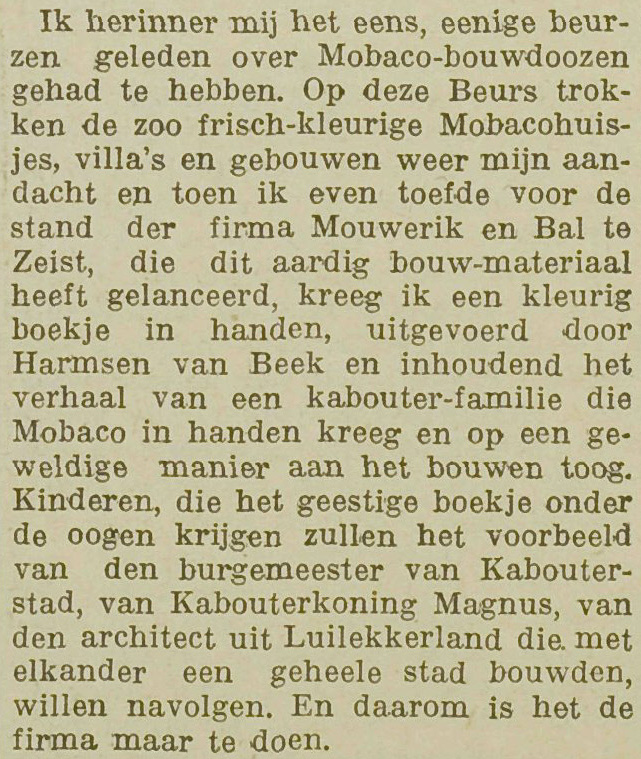 |
|||||||||||||||||||||||||||||||||||||||||||||||||||||||||||
THE GNOMES MARKETING BROCHURES (HET KABOUTERBOEKJE) There are three versions of this colorful sales brochure, featuring a family of gnomes ("kabouters" in Dutch) living in a Mobaco world. The illustrations are by artist ter Harmsen van der Beek. DATING The brochures are undated, but in a 17 September 1931 article about the Jaarbeurs fair in Utrecht (see above), the gnome brochure is mentioned. No such mention is in the 1927 Jaarbeurs article. The first edition of the brochure announces a new Set Z with new parts, which are also shown in an article in "Natuur en Techniek" in 1931, which indicates that Version 1 might be from 1931 or before. Interestingly, this would be 3 years before the first price list with a ter Harmsen van der Beek illustration (1934). Based on the sets mentioned in the brochure, the first version of the gnomes brochure could have been issued as early as 1926, the year that sets 3, 4 and Stations No. 1 and No. 2 were issued. However, the last page of Version 1 mentions that there are 11 sets available. It is unclear whether this includes the "brand new Set Z, in preparation" or Set 000, which is not shown in the book, but it must include Set 2a, so Version 1 must be from the same year or after the introduction of Set 2a. So far, we don't know when exactly Set 2a was introduced, but it was between 1928 and 1931, and most likely in 1931 as all known examples of Set 2a have square windows, which were introduced in 1931. The description of Set 3 mentions that all models in this booklet are taken from construction manuals. This indicates that the models featured in the Set 1-4 gnomes manual were already available by this time. The description of Set 4 references a "manual for Set 4" which may indicate there was a separate manual that pre-dates the Set 1-4 gnomes manual. This makes sense, as Sets 3 and 4 were introduced in 1926, while the Set 1-4 gnomes manual probably came out after the Set 1+2 art deco manual. My theory is that this gnomes brochure, the Set 1-4 gnomes manual and the Set 00-0-1 gnomes manual were all introduced at the same time, somewhere between 1927 and 1931, and most likely in 1931, the year the gnomes brochure is mentioned in the Jaarbeurs article. In the 1931 Natuur & Techniek article, we see them packing Set 0 art deco manuals, but these pictures were probably taken shortly before the introduction of the gnomes manuals. That same article shows the production of square windows, which would indicate that these gnomes books, which have round windows, are from before 1931. However, preparation of these books will have taken a while, so my guess is that they were still using round windows when ter Harmsen van der Beek was commissioned to make these books in 1930. They decided to move to square windows for a more "modern" look in early 1931, but it was too late to change the artwork. All this is conjecture. This also means that from 1926 through 1930, there may have been another manual for Sets 3 and 4, possibly similar in design to the large "village" manual, showing Models 41 through 80, but so far none have been found. An important difference between the three brochures is the page with picnicking gnomes. In version 1 (left), it features Set Z. In version 2 (middle), there is a technical drawing of the new Set 000, with a square window, and a flower pot copied from the Set 00 page. Version 3 (right) has an artsy version of Set 000, with a new "door" design: |
|||||||||||||||||||||||||||||||||||||||||||||||||||||||||||
 |
|||||||||||||||||||||||||||||||||||||||||||||||||||||||||||
THE GNOMES MARKETING BROCHURE (HET KABOUTERBOEKJE) - VERSION 1 WITH SET Z (PROBABLY ISSUED IN 1931) - DUTCH VERSION This book features sets 00, 0, 1, 2, 3, 4, and Stations No. 1 and No. 2, and includes a set that was never issued, Set Z. This set included a series of new parts, which are enumerated in the description: a chimney, a stairway, a conservatory, a balcony, a new entry door, a taller gate, a canopy and a flag pole, all in different colors. 


 
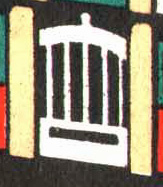

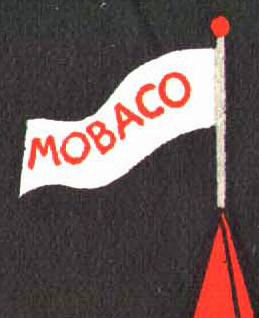 These items are also shown in a 1931 article in Natuur & Techniek (see picture below). None of these items were ever taken into production except the flag pole, part 161, and the front door, part 14, but with a different design - see Gnomes Book version 3 below.  BTW, as far as I know, the flag pole was already in production and included in Sets 3 and 4, which were introduced in 1926. The flag pole is featured in just one model, model no. 65, a grand Set 4 building in the Sets 1-4 Gnomes manual. Train Station no. 1 is drawn incorrectly, the main building is 3 x 4 columns large, not 4 x 4 as shown. There are also English, German and Spanish versions of this manual.  232 x 173 mm 12 pages (incl. covers) Colored covers and pages See pages DOWNLOAD PDF |
|||||||||||||||||||||||||||||||||||||||||||||||||||||||||||
 Scans courtesy Leen Kalden ENGLISH VERSION This is the English version of this booklet! It's an exact copy of the Dutch version 1. The translation of some of the items in the new Set Z is a bit odd: Dutch description English description conservatory closed verandah balcony open balcony taller gate new high-pile work canopy penthouse flag pole flag-staff  232 x 173 mm 12 pages (incl. covers) Colored covers and pages See pages DOWNLOAD PDF 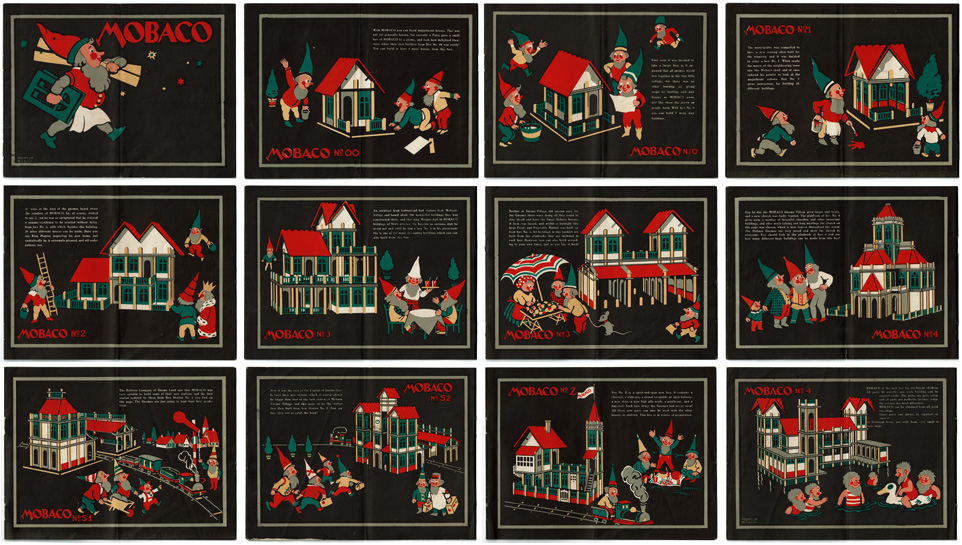 Scans courtesy Henri de Graaf GERMAN VERSION This is the German version of this booklet. It's an exact copy of the Dutch version 1.  232 x 173 mm 12 pages (incl. covers) Colored covers and pages See pages DOWNLOAD PDF 
Original courtesy of Nick Cranendonk SPANISH VERSION This is the Spanish version of this booklet. It's an exact copy of the Dutch version 1.  232 x 173 mm 12 pages (incl. covers) Colored covers and pages See pages DOWNLOAD PDF (200dpi) 
Original courtesy of Nick Cranendonk |
|||||||||||||||||||||||||||||||||||||||||||||||||||||||||||
THE GNOMES SALES BROCHURE (HET KABOUTERBOEKJE) - VERSION 2 WITH SET 000 (PROBABLY ISSUED IN 1932) This book features the same sets as version 1 above, except Set Z has been replaced with the new Set 000. The same picnickers are featured in the background, and the drawing of the little house is very technical and not in keeping withe the other pages, which suggests it was not done by Harmsen van Beek, but by a Moubal employee. Note that the window in Set 000 has square upper lights instead of round. This indicated the brochure was prepared as they introduced the square upper windows. The next version of the booklet has all square windows. Set 000 was introduced in 1932, so this brochure must be from 1932 or later.  232 x 173 mm 12 pages (incl. covers) Colored covers and pages See pages DOWNLOAD PDF |
|||||||||||||||||||||||||||||||||||||||||||||||||||||||||||
 Scans courtesy Leen Kalden |
|||||||||||||||||||||||||||||||||||||||||||||||||||||||||||
THE GNOMES SALES BROCHURE (HET KABOUTERBOEKJE) - VERSION 3 WITH SQUARE WINDOWS AND ART DECO DOORS (PROBABLY ISSUED IN 1933, OR LATER) This book features the same sets as version 2: 000, 00, 0, 1, 2, 3, 4, and Stations No. 1 and No. 2. The house for Set 000 is redrawn to be more in keeping with the other pages. All windows now have square upper windows. This booklet features a new version of the door, a gray panel with 4 vertical openings which we refer to as the Art Deco door. This part was soon discontinued, as this "door" blocked access to the inside of the house, and thus limited the play value. And unlike the original door, the Art Deco version couldn't be used as an open arch to support upper levels or roofs, necessary in certain models such as the Train Stations. Only a few sets have been found with this door design. For the rest, all drawings are the same as version 2. Assuming this brochure is at least a year later than version 2, it must be from 1933 or later. 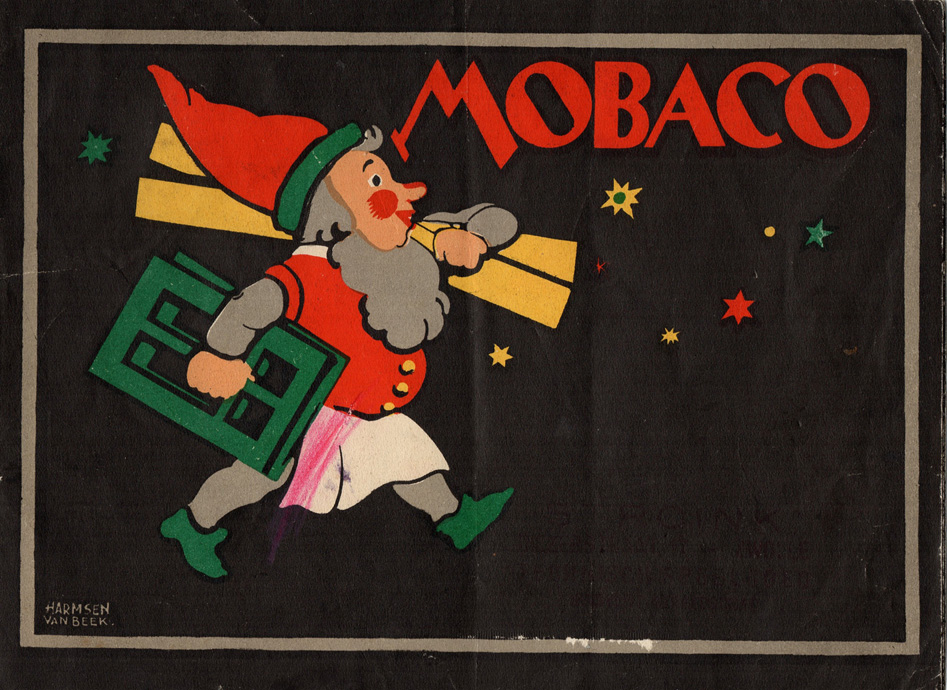 232 x 173 mm 12 pages (incl. covers) Colored covers and pages See pages DOWNLOAD PDF |
|||||||||||||||||||||||||||||||||||||||||||||||||||||||||||
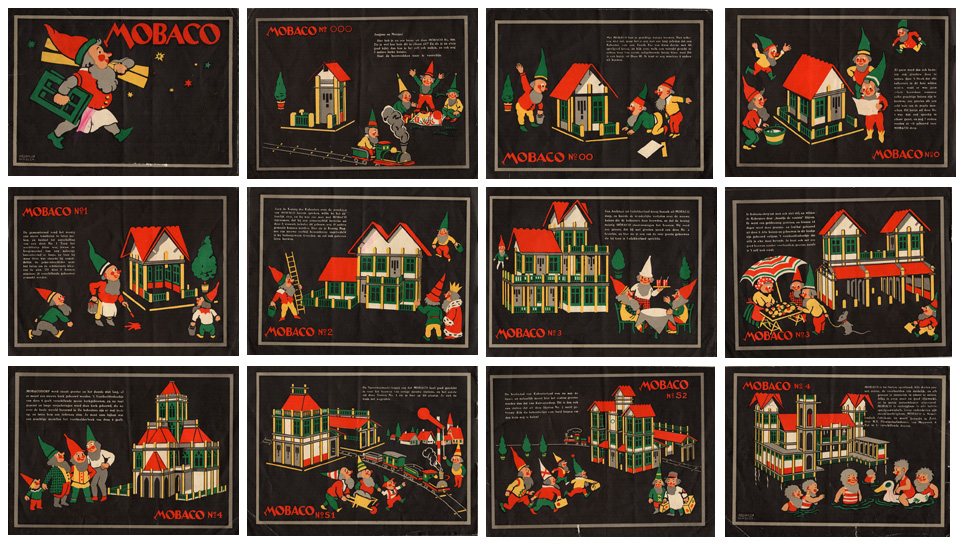 Scans courtesy Alex Geelhoed |
|||||||||||||||||||||||||||||||||||||||||||||||||||||||||||
Ads for Mobaco demonstrations A good form of marketing are demonstrations. In various ads, Mobaco demonstrations were announced. Here ones found so far by avid Mobaco researcher and contributor Leen Kalden. It appears they were held primarily in 1931 through 1934. Warenhuis Van den Borg in Nijmegen, and E. van der Hart & Zoon in Arhnem were particularly active in promoting Mobaco. |
|||||||||||||||||||||||||||||||||||||||||||||||||||||||||||
|
|||||||||||||||||||||||||||||||||||||||||||||||||||||||||||
Unpriced Mobaco ads - Moubal period (1924 - 1951) The primary form of Mobaco advertisement were newspaper ads by local toy stores. Here a smattering of ads that mention Mobaco. Occasionally, Mobaco will be the focal point of the ad, but more often than not, it appears among other toys such as Meccano and toy trains. Ads with prices are located in the Price Lists page. |
|||||||||||||||||||||||||||||||||||||||||||||||||||||||||||
|
|||||||||||||||||||||||||||||||||||||||||||||||||||||||||||
VAN DEN BOSCH, ZEIST Mobaco was first sold at the store of Firma G. van den Bosch, Slotlaan 18 in Zeist - see the 1924 ad on Sets page. Here a picture of the store from a 1932 advertisement:  Image courtesy of Leen Kalden - from Gids van Zeist en de Stichtsche Lustwarande, 1932 |
|||||||||||||||||||||||||||||||||||||||||||||||||||||||||||
BOSCH HONIG, UTRECHT NV Bosch Honig in Utrecht had a special relationship with Moubal. They were one of the first sales outlets of Mobaco, and for a while were its sole distributor. I don't have much information on them, here what I found. In 1929, their store was located at Korte Jansstraat 1 & 1-bis in Utrecht, now a eyeware store. By 1927 they had moved to Domstraat 6, Utrecht. Bosch Honig had a stand at the Jaarbeurs fair in Utrecht in Spring 1925, see newspaper clipping above. They may also have been present at the fair in Fall 1927, but the clipping isn't clear whether it was van Mouwerik & Bal or Bosch Honig who had a stand. They sold Mobaco in 1925 (article Jaarbeurs), and it appears they were the sole distributors of Mobaco in 1926 (Undated Price List #1), 1927 (article Jaarbeurs) and through the September 1931, according to advertisements in De Groene Amsterdammer and De Joodsche jeugdkrant Betsalel - see below. 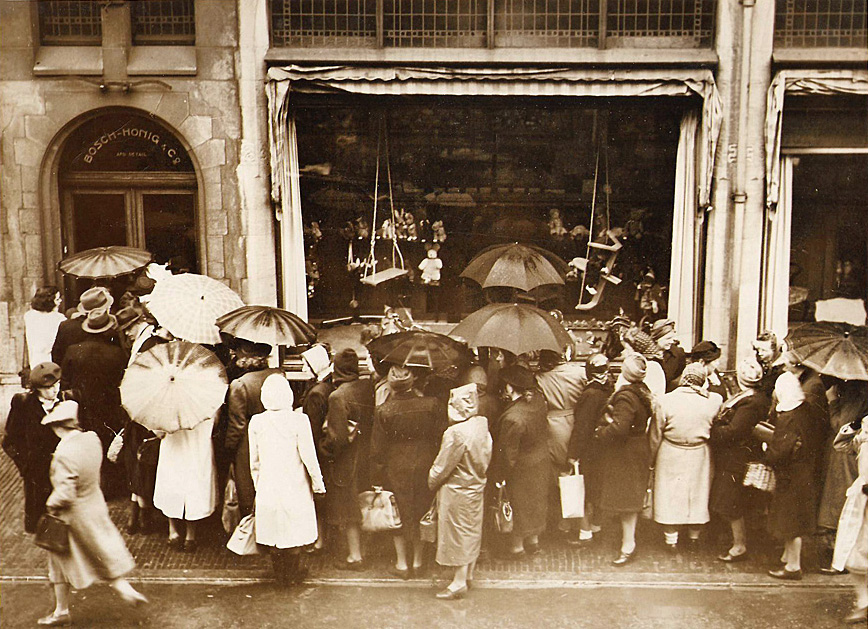 Image courtesy Leen Kalden Here a Bosch Honig envelope from 1929, featuring a large stamp of Model no. 76 (as shown on the back of the 1924 Set 2 manual), which was stamped over the envelope seal. Their address is Korte Jansstraat 1 & 1-bis, Utrecht. |
|||||||||||||||||||||||||||||||||||||||||||||||||||||||||||
  Scans courtesy Leen Kalden This ad appeared pretty much unchanged every two weeks in De Groene Amsterdammer from 9 January 1926 through 22 December 1928, then after a year hiatus again from 28 December 1929 through 27 December 1930. The ads mention that N.V. Bosch Honig are the sole agent for the Netherlands ("alleenverkoop"). The illustration is building #34 from Set 2. Address is Domstraat 6 in Utrecht:  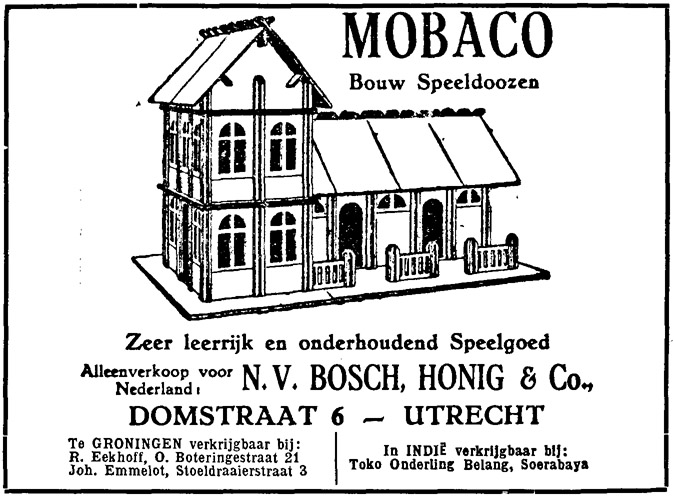 De Groene Amsterdammer, 22 January 1927 De Groene Amsterdammer, 9 June 1928 This ad appeared unchanged every month in De Joodsche jeugdkrant Betsalel from April 1928 through July 1929, then in October and November 1929. In 1930 the ad appeared in July, October and December. In 1931, the ad appeared in March, April, August and September. All ads mention that N.V. Bosch Honig are the sole agent for the Netherlands ("alleenverkoop"). The illustration is building #52 from Set 3: 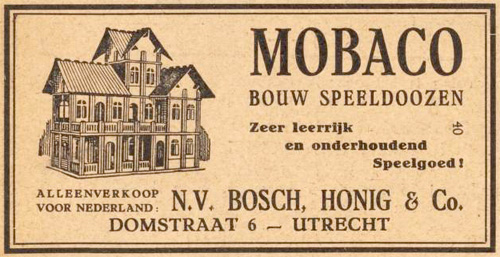  De Joodsche jeugdkrant Betsalel, 4 April 1928 De Joodsche jeugdkrant Betsalel, 24 September 1931 |
|||||||||||||||||||||||||||||||||||||||||||||||||||||||||||
MARKETING IN THE
JUMBO PERIOD (1949 - 1961)
|
|||||||||||||||||||||||||||||||||||||||||||||||||||||||||||
After the war, there was a shortage of everything. It took a while for industry to get going again, and toys were a low priority. Hausemann & Hötte started selling Mobaco in 1949 under the Jumbo brand, and the initial ABC series appears prominently in their 1949 catalog "Het Speelgoedboek". Several of the Hausemann & Hötte catalogs are shown on the Price Lists page. Mobaco is last featured in the 1961-1962 Jumbo catalog. The toy simply was too dated and new "modern" toys such as Lego were on children's minds. Thus ended Mobaco's 38 year history, from the Fall of 1924 through the Summer of 1962... Jumbo Display Poster (1955?) This lovely cardboard poster is not dated. On the back there is a little triangular ring to hang it from a nail. Many of the parts shown on the poster didn't appear in any of the Jumbo sets, not even set E, the largest set. You could special-order these parts through your toy store. As you can see, some of the pre-war parts were no longer available. As with the illustration on the Jumbo box lids, the buildings are shown much larger than they really are. Strangely, the gray parts are shown brown in the perspectives. Also the half door (part 54) in the large building is shown with an upper opening, and the window in the boy's hand and on the floor behind him doesn't resemble a Mobaco window. Finally, there is a window with round openings on the floor behind the girl. These had not been produced since 1931! DATING: In the Dealer Chest, we find two parts of this poster cut out and glued to the inside of the lid: the Mobaco logo and the parts illustration. If you look closely you see that a green base plate projects into the frame of the parts illustration. This little projection is visible in the Dealer Chest, so it's clear that the illustrations in the Dealer Chest come from this poster. All known examples of the Dealer Chest feature these cut-outs, so the poster probably came out before or at the same time as the Dealer Chest. The Dealer Chest is first seen at the 1955 Jaarbeurs trade fair (see below), so the poster must be from 1955 or before. Size: 375 x 499 mm View 300dpi image  Original courtesy of Deventer Speelgoedmuseum Here an enlargement of illustrator's signature. it reads Jan Stee or Steeg or Steeyen. We haven't found yet who that is:  |
|||||||||||||||||||||||||||||||||||||||||||||||||||||||||||
Hausemann & Hötte display at the 1955 Jaarbeurs trade fair Here two photo's of Hausemann & Hötte's booth, displaying their Jumbo products, including a big Mobaco banner, a large Mobaco building, and a dealer's chest. Outside view, with their name just visible in the top-left corner of the photo. The walls are lined with other Jumbo products such as Electro:  Inside view, with a dealer chest open on the left side. There is some imaginative use of parts in the model, including using ground plates for the intermediate floors, and a bit of glue here and there to keep parts in place that would otherwise fall to the ground:  Images courtesy of Leen Kalden |
|||||||||||||||||||||||||||||||||||||||||||||||||||||||||||
In 2023, Caspar Mol
rebuilt this display in LeoCAD: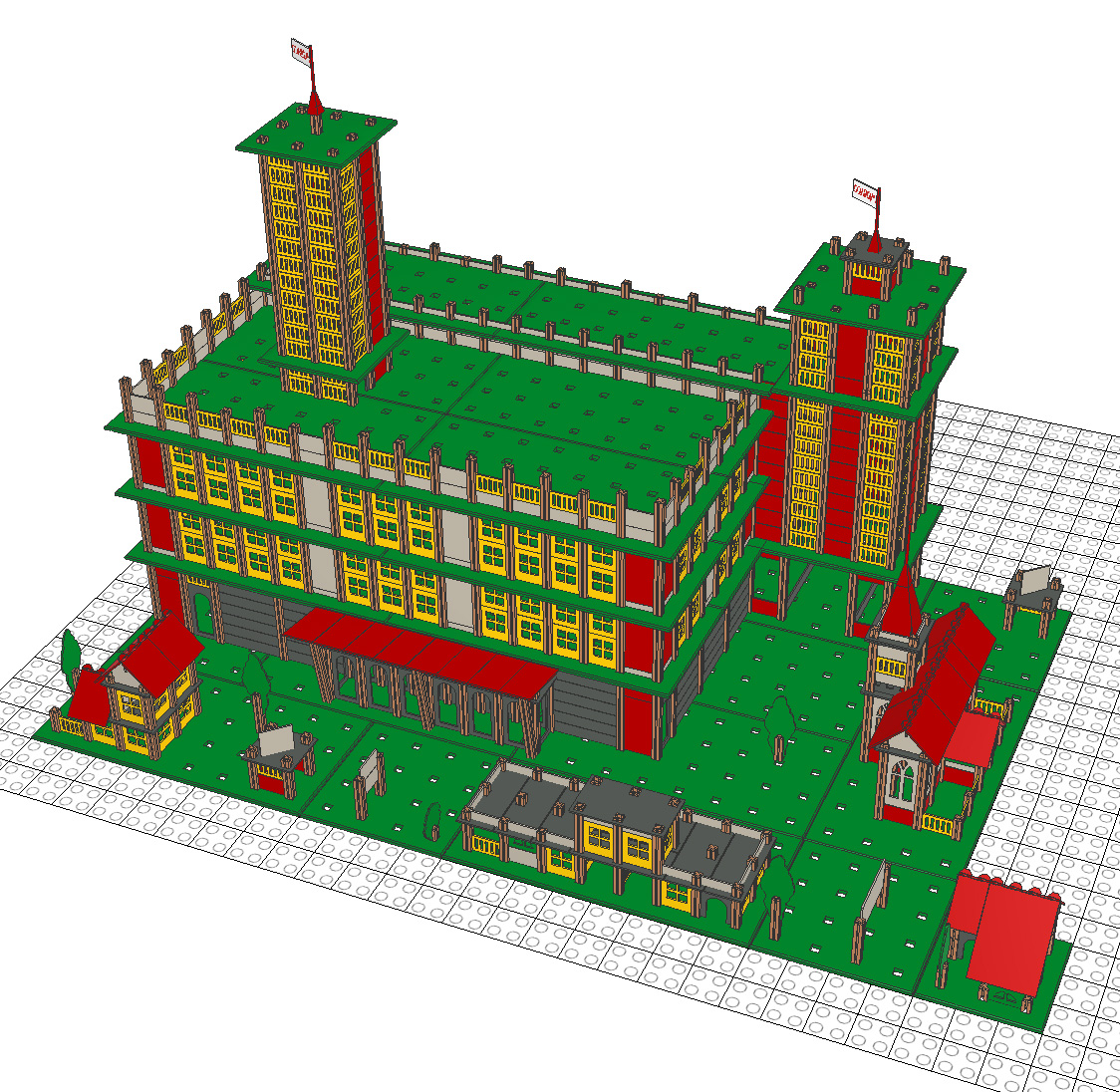 Here side-by-side the 1955 photo and the 2023 reconstruction. The black and white photo doesn't show how colorful it was!   Images courtesy of CM |
|||||||||||||||||||||||||||||||||||||||||||||||||||||||||||
Unpriced Mobaco ads - Jumbo period (1949 - 1961) In addition to toy catalogs, Hausemann & Hötte typically placed quarter-page ads in November in magazines such as Libelle. But toy stores still put out ads with Mobaco, although it often has no prominence. Below a smattering of ads collected from various (mostly on-line) newspapers. Firma Den Uijl was very active in 1951, for the rest it's surprising how little there really is. A notable exception is this large newspaper ad from November 1958 in Algemeen Handelsblad. I suspect interest was starting to wane, and Hausemann & Hötte gave it their best shot for the Sinterklaas/Christmas season: 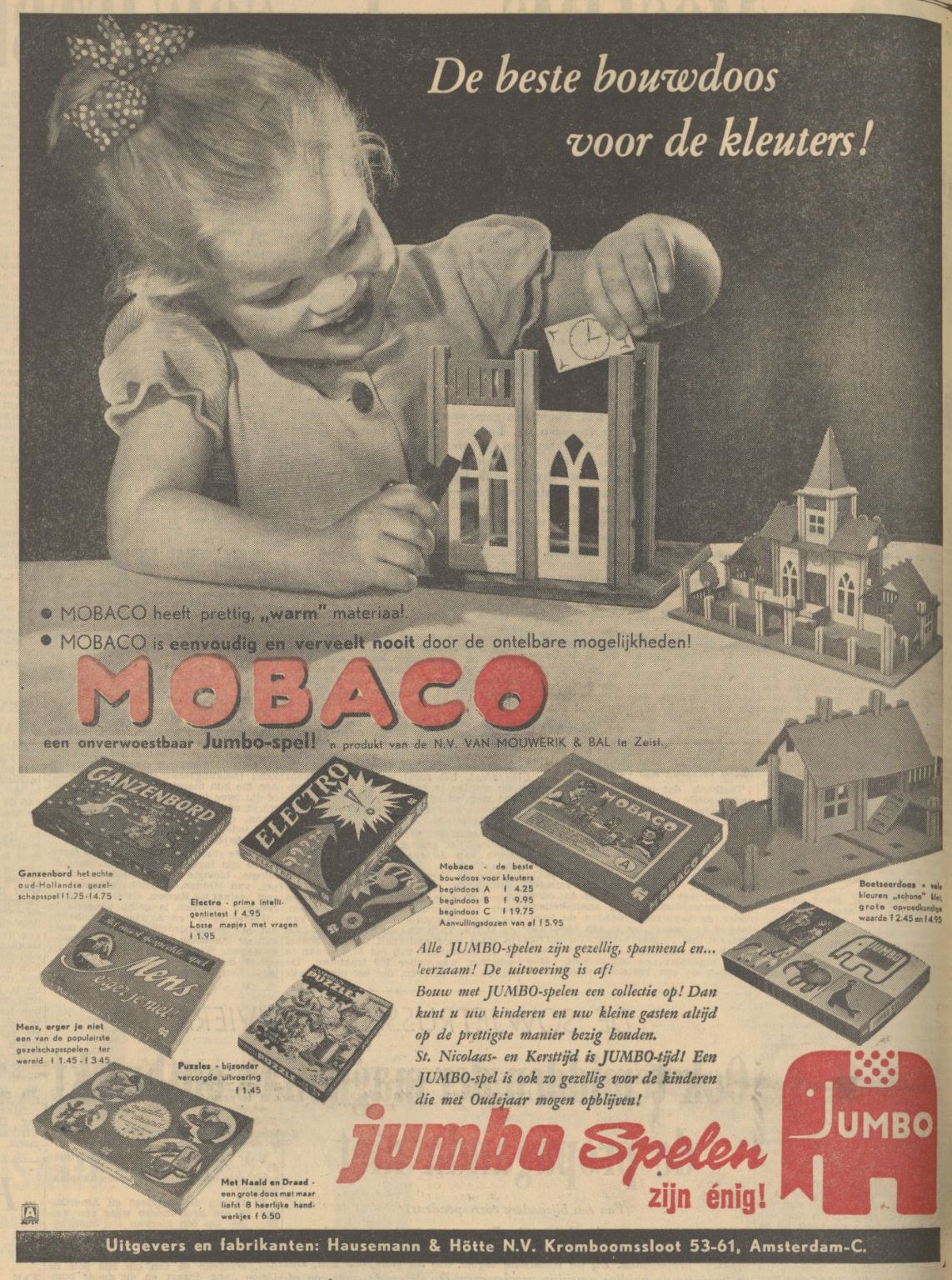 Image courtesy of delper.nl |
|||||||||||||||||||||||||||||||||||||||||||||||||||||||||||
|
|||||||||||||||||||||||||||||||||||||||||||||||||||||||||||